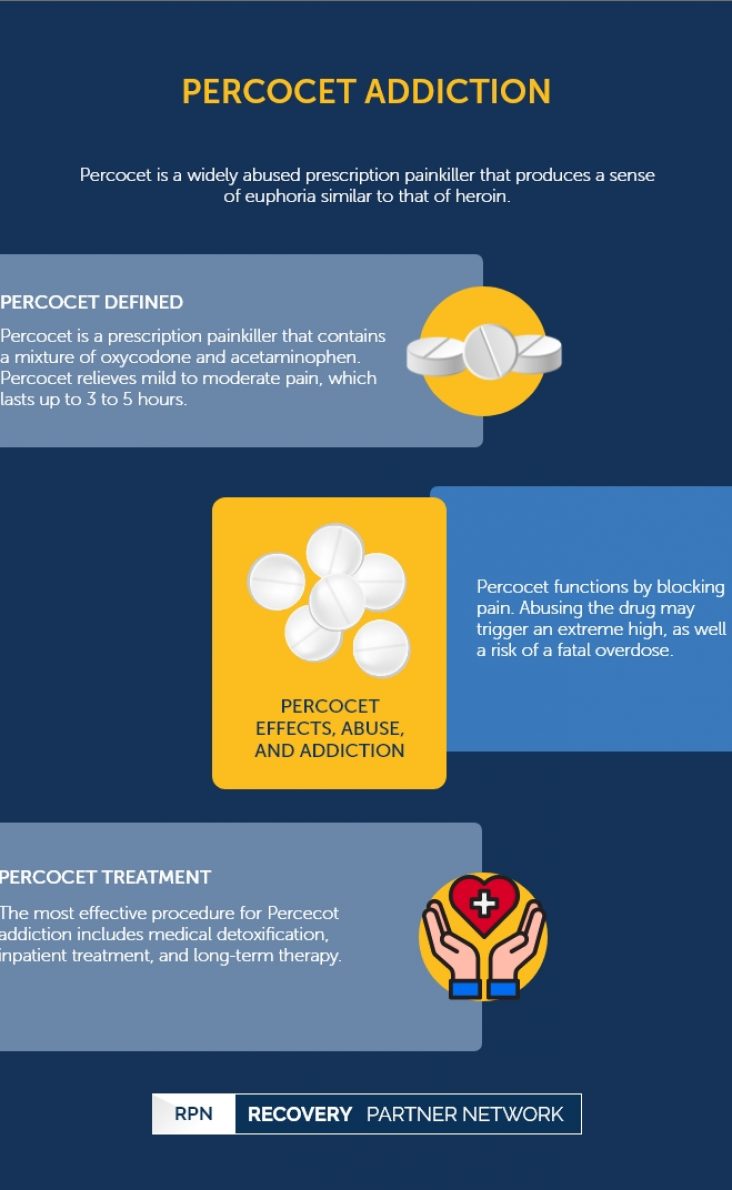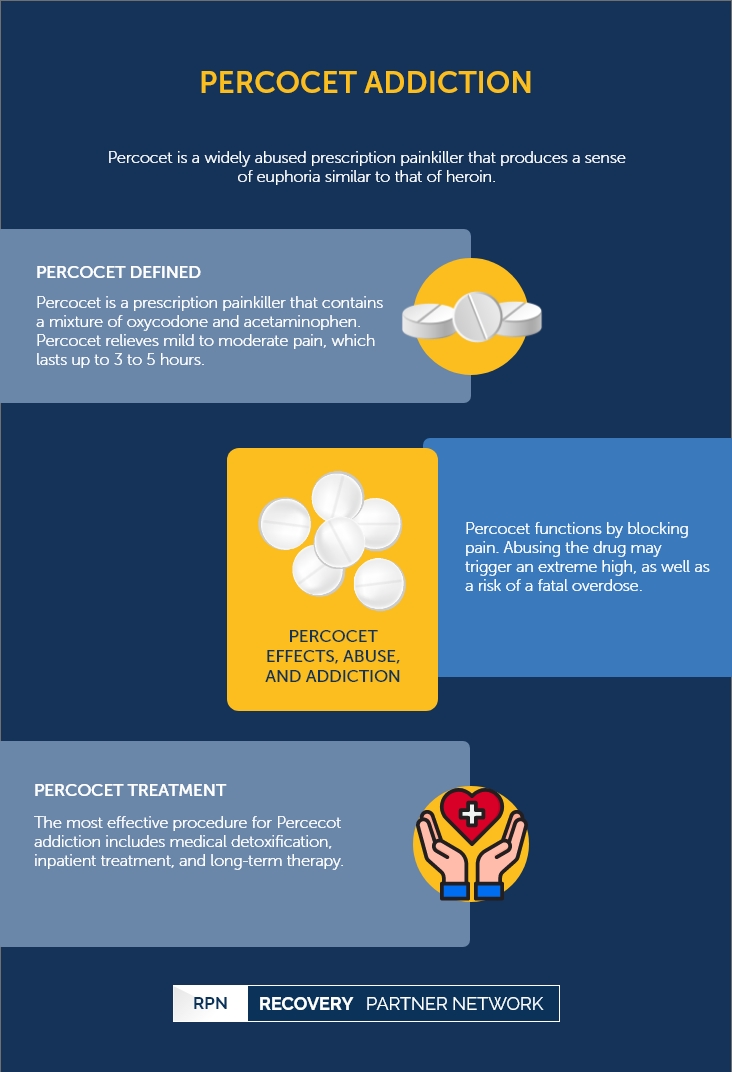Percocet is a widely abused prescription painkiller that produces a sense of euphoria similar to that of heroin.
Percocet Addiction
Opioid
- Hydrocodone/paracetamol addiction
- Buprenorphine/Naloxone addiction
- Central nervous system depressant
- Codeine addiction
- Dextropropoxyphene addiction
- Fentanyl abuse
- Hydromorphone addiction
- How Long do Opioids Stay in Your System?
- Hydrocodone addiction
- Kava addiction and abuse
- Loperamide addiction
- Lortab addiction
- Medical prescription opioid
- Methadone addiction
- Morphine addiction
- Norco addiction
- NyQuil addiction
- Opioid use disorder
- OTC substance abuse
- Oxycodone addiction
- Oxycodone/paracetamol addiction
- Opioid epidemic
- Lean addiction
- Pethidine addiction
- Snorting Oxycodone
- Synthetic Opioids
- Tramadol addiction
Oxycodone/paracetamol addiction | Table of Contents
Percocet Defined
Percocet is a prescription painkiller that contains a mixture of oxycodone (semi-synthetic opioid) and acetaminophen (the active ingredient of Tylenol). Percocet relieves mild to moderate pain, which lasts up to 3 to 5 hours. The pain-relieving effects of Percocet are generally experienced around 20 to 30 minutes after its use.
Acetaminophen is used for reducing fever and pain in patients. Prolonged consumption of acetaminophen does not cause habit-forming practices. However, acetaminophen may trigger undesirable effects when used in large doses, such as liver disease. Oxycodone belongs to a category of medications known as narcotic analgesics. This substance acts on the central nervous system (CNS) to alleviate pain.
Due to the high risk of abuse and addiction, even at prescribed doses, Percocet is only recommended when treatment with non-opioid pain-relieving medications are ineffective. Percocet is a Schedule II drug, which indicates a high potential for abuse that could contribute to severe psychological or physical dependency.
FAQ
Percocet is comprised of a combination of acetaminophen and oxycodone.
Percocet is an opioid painkiller, and it is the brand name for the combination medication of oxycodone and acetaminophen. The oxycodone portion of Percocet is the opioid, whereas the acetaminophen portion of Percocet is the same ingredient found in the over-the-counter pain medication, Tylenol.
Percocet pills vary by color and shape depending on their strength. A strength of 2.5 mg per 325 mg is available in a pink, oval tablet, with 2.5 etched on the surface. Strength of 5 mg per 325 mg is available in a blue, round tablet, with 5 etched on the surface.
Percocet Effects, Abuse, and Addiction
Opioids, such as Percocet, block pain by changing the chemical pathways in the brain associated with pain sensations, as well as slow down a few of the central nervous system’s functions, such as respiration, blood pressure, and heart rate. Neurotransmitters, which are the natural chemical messengers of the brain responsible for sending dopamine, are also disrupted by Percocet’s use or abuse. Percocet is also exploited for its narcotic effects.
High doses of Percocet may generate a euphoria similar to that of heroin. The abuse of Percocet pills in the form of crushing and snorting or smoking it or diluting and injecting it forces the substance directly into the user’s bloodstream all at once. These methods of abuse may trigger an extreme high, as well as a risk of a fatal overdose. Abuse of Percocet can also lead to the abuse of other potent and illicit substances.
Effects of Percocet Addiction
Since Percocet is typically prescribed on a short-term basis, individuals who form an addiction to it may look at other illicit means to continue their abuse.
Individuals with an addiction to Percocet may display risky behaviors such as:
- Procuring the drugs from the streets illegally.
- The use of a fake prescription.
- Stealing the medication from others.
- Consulting multiple doctors or doctor shopping.
Opioids like Percocet can cause severe health complications such as the increased risk of choking, disruptions to a person’s breathing, and increased risk of an overdose that can result in fatal consequences.
Common side effects of Percocet include:
- Constipation
- Dizziness
- Drowsiness or sleepiness
- Blurred vision
- Confusion or muddied thinking
- Nausea
- Upset stomach
- Headache
- Itching
- Vomiting
When taken in large doses or abused, Percocet side effects may include:
- Flushing or sweating
- Low blood pressure
- Mood swings
- Confusion
- Depression
- Slowed breathing
- Trouble concentrating
- Problems with co-ordination
Percocet Withdrawal
The abrupt cessation of Percecot consumption may cause incredibly painful opiate withdrawal symptoms that begin 6 to 30 hours after the last dose. For most patients, withdrawal symptoms significantly improve within 5 to 7 days. Due to the severity of withdrawal symptoms, patients are highly advised to seek medical assistance if they wish to quit the use of Percocet.
Symptoms of Percocet withdrawal include:
- Depression
- Diarrhea
- Feeling irritable and anxious
- Feeling restless
- Appetite loss
- Chills
- Cramps
- Irregular heartbeat
- Muscle or joint aches
- Runny nose
- Sweating
- Vomiting
- Nausea
- Problems sleeping
- Rapid breathing
- Weakness
- Yawning
Percocet Overdose
The two ingredients found in Percocet can increase the risk of an overdose. This risk is significantly increased by the use of other medications that contain acetaminophen. Since acetaminophen is found in many combination drugs, patients may encounter an accidental overdose if not cautious. Combination medications, such as Percocet, are also regulated to 325 milligrams of acetaminophen per pill, capsule, or other dosing units to avoid such occurrence.
Symptoms of Percocet overdose may include:
- Difficulty breathing
- Dizziness
- Bluish skin, fingernails, and lips
- Cold and clammy skin
- Excessive sleepiness
- Limp or weak muscles
- Loss of consciousness or coma
- Fainting
- Slowed or stopped breathing
- Slow or stopped heartbeat
Percocet Statistics
- 152 Percent: Emergency room visits due to painkillers rose by 152 percent between 2004 and 2008.
- 46 Percent: Prescription opioids are the most prevalent substance involved in drug-related medical emergencies. Forty-six percent of drug-related medical emergencies involved opioids in 2013.
- 78 Thousand: Of the estimated 78,000 deaths in 2010 was caused by illegal drug use, more than half were caused by painkiller addictions.
Percocet Treatment
As with any opiate addiction, Percocet addiction recovery requires the assistance and guidance of a professional and medical service. Rehabilitation for Percocet abuse is similar to that of other prescription opioids, such as OxyContin or morphine. The most effective procedure for Percecot addiction includes medical detoxification, inpatient treatment, and long-term therapy.
Detox is often the most physically difficult stage to overcome in this process due to the severity of withdrawal symptoms. Many recovering patients complain of muscle aches and insomnia as some of the most difficult symptoms experienced. Percocet detox includes the gradual tapering down method with the assistance of medications. Medications, such as clonidine and buprenorphine, are used in combination with therapy to help a patient taper off Percocet safely.
After the completion of detoxification and inpatient treatment programs, patients are highly advised to continue with treatment through an aftercare program to maintain sobriety and prolong recovery.
Recovery Partner Network
We aim to educate and empower. If you feel our library of resources does not cover your specific need, reach out to us, and we would be happy to help.
STATISTICS
© Copyright 2025


